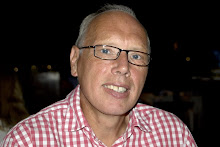The Future of e-Learning in Higher Education:
By 2001, many institutes had created established course management systems (as opposed to their teachers using a variety of management systems).
The question asked was: are we starting to see the end of the institute course management systems? Are many of the functions in the CMS being replaced with Web 2.0 services; which are supplied externally to the institute (wikis, social networks,...)?
It was agreed that the answer would be to use SOAs with well defined standards, so that it would be possible to integrate added services to a CMS framework. Cardiff is using this approach with Sakai as the underlying framework.
Many people are concerned that Blackboard acquired WebCT (and the forced migration of users of the latter) - and universities are now actively looking for Open Source alternatives (Moodle is the favourite, then Sakai).
Green IT
It is estimated that IT 's carbon contribution is 2% of the total (roughly the same scale as aviation).
But within higher education, for universities which do not run large pieces of scientific equipment, the IT share is estimated to be between 15 and 20% total.
{http://www.ghg.protocol.org enables you to do your own calculations.}
The consequence is that changes to IT can offer significant carbon savings within a university as a fraction of the whole.
The effects of ICT on environmental sustainability:
- Negative: Greenhouse gas emission in manufacture. waste, hazardous substances, use of scarce resources
- Positive: Travel substitution, transport optimisation, e-Business and e-Government, environmental controls systems
- Printing (6%): mainly paper and not the energy to print
- LAN and Office Telecoms (7%): difficult to tackle
- Mobile Telecoms (9%)
- Fixed-Line Telecoms (15%)
- Servers including cooling - data centre (24%)
- PCs, etc (39%): focus should be here
It is recommended to undertake an environmental assessment, and set targets for power consumption and carbon levels.
It is estimated that 2,500 PCs and laptops cost 64kEuros in electricity over a year. it is relatively easy to halve this.
Data Centres are intending to cut power by:
- virtualizing
- stopping over-provisioning
- using power management to throttle power based on use
- using a low power state or shutting servers down when not in use
- smart energy management (directing cooling)

4 comments:
Its good to see that at Oxford we're focusing first on power management on PCs, and over the slightly longer term virtualisation of the extensive server infrastructure.
I suspect most of the energy saving models greatly underestimate what is termed the embodied energy costs associated with manufacturing ICT equipment. Most manufacturers are unable to tell their customers this contribution to climate change.
Oxford is also employing Sakai as a SOA framework (I wasnt aware that Cardiff were also active in this area). (Sakai uptake is steadily increaing in the UK; Cambridge, Hull and Oxford will all have institutional VLE's based on Sakai in the next year or so. Other institutions (eg, Lancaster, Newcastle) also use it to a lesser extent.
When asked, I suggest that any new tools or services developed within Oxford University Computing Services sould be done so in the Sakai framework.
There is an obvious overhead in slotting something into an existing famework; the tendancy is to 'just get the current tool out of the way quickly and have a look at the framework next time' but I believe in the long run it is more sensible to bite the bullet now and start designing institutional services around the famework! Think of it as slightly nasty tasting medicine that will make you feel better in a couple of years!
In addition to the above-mentioned overhead, one also has to sidestep the 'not invented here' syndrome: people like their own silo of independent web apps, they can keep things close at hand and dont have to worry aout the bigger picture when making changes.
But one of the many brilliant things about Sakai is that non-Java web applications can be embraced by the use of the 'Link Tool' which gives a thrid party application a hook into the framework to retrieve user and other session information.
In general it is far easier to plug Open Source software into an SOA framework not only because both ends of the link can be modified but also becuase, in general, open source solutions tend to have much better support for Open Standards than closed source solutions.
Open standards are one of the keystones of SOA development and commercial software vendors tend only to pay lip-service as they generally have no interest whatsoever in allowing their users to extract their data from a system and move it somewhere else!
Our team at the Gilfus Education Group just released this white paper to provide critical insights to practitioners while clarifying "Social Learning" as a concept.
Social Learning Buzz Masks Deeper Dimensions Mitigating the confusion surrounding “Social Learning” (Download Here)
It is our hope that by leveraging socially based technologies the education industry can shape a new educational technology paradigm that realizes the promises of true “Social Learning”.
By understanding its applications we can create a unique opportunity to improve student engagement, student retention, academic success and overall educational outcomes.
– Stephen Gilfus, Gilfus Education Group (Founder Blackboard Inc. left the organization in 2007)
Post a Comment